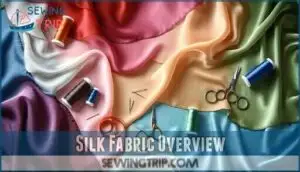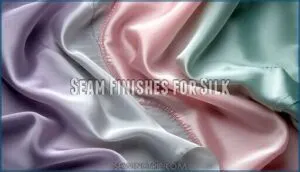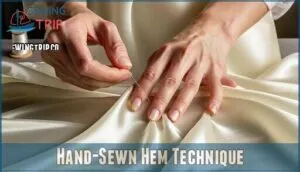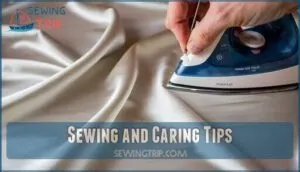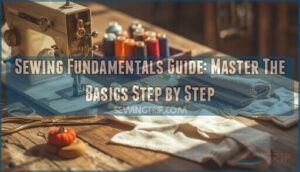This site is supported by our readers. We may earn a commission, at no cost to you, if you purchase through links.

If you’re working with lined silk, pinned edges can minimize unraveling while keeping things simple.
For unlined garments, bias-bound or Hong Kong seams add a professional touch with minimal bulk, while a serger (set with three threads) balances efficiency and finesse on less formal pieces.
Always use sharp needles, lightweight thread, and low heat when pressing seams to protect silk’s delicate nature.
The right finish elevates your silk project effortlessly.
Table Of Contents
Key Takeaways
- Use French seams to enclose raw edges, stop fraying, and add a clean, polished finish to lightweight and sheer silk fabrics.
- Bias-bound edges or Hong Kong seams are excellent for mid-to-heavyweight silks, offering durability and professional interiors.
- Always use sharp needles, lightweight thread, and low heat when pressing to protect silk’s delicate nature and prevent damage.
- For hems, go with a baby hem or a hand-sewn method to achieve a smooth, professional result without adding unnecessary bulk.
Silk Fabric Overview
You’ll find silk fabric in varieties ranging from lightweight chiffon to textured dupioni, each demanding specific seam finishes to prevent fraying and enhance durability.
Working with silk requires precision and care, but you’ll achieve professional results by selecting the appropriate technique for your specific silk type.
Types of Silk Fabrics
From luxurious evening gowns to delicate lingerie, silk fabrics come in various types depending on their Fiber Source, Weave Structure, and Silk Weight.
Common silk varieties include:
- Chiffon – lightweight and sheer with a soft drape
- Georgette – slightly textured with a crepe finish
- Satin – glossy surface with a dull back
- Dupioni – crisp with slubby texture from irregular threads
Understanding these silk fabrics helps you select appropriate finishing techniques. Consider fabric weight for thickness when choosing your silk, and note the importance of silk weight and fabric weight in this process.
Characteristics of Silk Fabrics
Many silk fabrics share distinctive properties that affect how you’ll handle them in your sewing projects.
Silk’s unique characteristics determine which seam finishes work best for your garment.
| Silk Type | Weight | Drape Quality |
|---|---|---|
| Chiffon | Light | Flowing |
| Charmeuse | Medium | Fluid |
| Dupioni | Medium | Structured |
| Taffeta | Medium | Crisp |
| Noil | Heavy | Textured |
Weight, drape quality, luster levels, weave types, and fiber content all influence your silk fabric’s behavior. The unique characteristics and silk fabric properties are crucial in determining the best approach for your sewing projects.
Handling and Caring for Silk
Silk’s delicate nature demands special attention during handling and care.
Silk’s grace lies in its delicacy—handle with care to preserve its timeless elegance and enduring beauty.
Pre-washing silk with lukewarm water and mild detergent prevents future shrinkage.
Always test a small fabric piece first.
Store in acid-free tissue paper away from direct sunlight.
- Your fingertips can detect microscopic snags invisible to the eye
- Every press of the iron could either restore or destroy your creation
- That perfect seam finish becomes your signature of craftsmanship
Seam Finishes for Silk
When working with silk fabric, proper seam finishes are essential for professional-looking garments.
Choosing the right technique depends on your fabric weight and project needs.
For sheer silks in unlined garments, consider French seams or bias binding to conceal raw edges completely.
Heavier silks benefit from Hong Kong finishes or serging for durability concerns.
Curved seams require special attention to prevent puckering, so trim seam allowances carefully.
Remember that silk fabric sewing demands precision – clean seam techniques also enhance appearance but extend your garment’s life.
Each silk seam finish method balances aesthetics with functionality.
To prevent fraying, one should consider cutting silk precisely.
French Seams for Silk
French seams give your silk projects a polished, clean finish by fully enclosing raw edges. They’re perfect for lightweight and sheer silks, offering durability while preventing fraying.
Benefits of French Seams
French seams add a touch of sophistication and deliver practical benefits for silk sewing.
French seams elevate your silk projects with elegance, ensuring durability, fray prevention, and a polished, professional finish.
They’re perfect for sheer fabrics, offering durability and a clean, high-end finish. Plus, these silk seam finishes prevent fraying while enhancing garment longevity.
- Durability Boost: Enclosed edges protect against wear.
- Clean Aesthetics: No raw edges visible.
- Fray Prevention: Edges stay intact over time.
- Perfect for Sheer Fabrics: Maintain an elegant, polished look.
Techniques for Creating French Seams
To create French seams, start by sewing the fabric wrong sides together with a narrow seam allowance, around 1/4 inch.
Trim excess to reduce bulk. Pressing techniques matter—press the seam to one side before flipping the fabric right sides together.
Sew a second seam, enclosing raw edges completely. For curved seams, trim carefully and clip along curves to prevent puckering.
This silk seam finish guarantees durability and elegance.
Tips for Working With French Seams
Precise seam finishing methods make all the difference in French seam silk projects.
When handling sheer fabrics or curved seams, start by trimming seams for bulk reduction before the second pass. Use sharp scissors for clean edges and follow a steady pressing technique between each step.
These silk sewing tips guarantee couture seam techniques look polished and durable, enhancing your French seams with a professional, elegant finish.
For a truly professional finish, remember the fabric’s suitability and applications, and consider the importance of professional finish and elegant finish in your work.
Hemming Silk Fabrics
Hemming silk requires precision and care to maintain the fabric’s delicate nature and smooth finish.
Whether you’re using a baby hem, hand-sewn hem, or a rolled hem technique, choosing the right method guarantees a clean, professional result.
Baby Hem Technique
Hemming lightweight silks calls for precision, and the baby hem is your go-to solution.
Fold the silk edge twice—1/8 inch each time—to encase raw edges. Secure tiny hems with a narrow stitch, keeping tension even to prevent slippage.
For curves, gently iron the fold before sewing. A specialized sewing foot can further simplify this process.
This rolled hem silk method is perfect for delicate fabrics, offering clean silk edge finishing without bulk, making it a great solution for delicate fabrics.
Hand-Sewn Hem Technique
A hand-sewn hem is perfect for silk edge finishing, creating a polished look with invisible stitches.
Use a fine needle and adjust thread tension to avoid puckering. When hemming curves or weighted hems, take your time securing corners for clean edges.
This technique works well on delicate fabrics, offering control and precision. Hand-sewn seams guarantee durability and elegance, making this method ideal for your silk projects.
Rolled Hem Technique
For lightweight silks, a rolled hem offers a clean finish that’s almost invisible yet sturdy.
Use a narrow hem presser foot or roll by hand for control. Rolled hem tools simplify edges, while variations suit your project’s flow.
Securing rolled hems is key—tighten tension and keep steady. Troubleshooting rolled hems often involves adjusting fabric placement.
Proper hemming transforms silk into an elegant, flowing masterpiece, with rolled hems that require attention to detail.
Advanced Seam Finishes
When you’re ready to elevate your silk sewing projects, advanced seam finishes offer both durability and refinement.
Techniques like flat felled seams, bias bound seams, and the Hong Kong bind create clean, professional edges ideal for high-end garments.
Flat Felled Seams
A flat felled seam for silk offers a neat, durable finish, enclosing raw edges inside the seam.
It’s perfect for sportswear or bulky silks, thanks to its strength and reversibility.
Start with a 5/8” seam allowance, trimming one edge before folding and topstitching. This technique suits any silk garment construction where durability matters, and the double stitching guarantees long-lasting seam finishes that look polished and professional.
Bias Bound Seams
Bias bound seams offer both aesthetic appeal and durability factors, making them perfect for silk.
By enclosing raw edges with bias tape, you’ll achieve clean finish seams that resist fraying.
They’re ideal for exposed seams or binding fabrics with curves since the bias tape flexes smoothly.
This sewing technique works beautifully in garments where the interior might be visible, ensuring professional results with silk’s delicate nature.
For a couture look, consider Hong Kong seam finishes to achieve a high-quality finish with advanced seam finishes.
Hong Kong Bind Technique
The Hong Kong finish is a timeless favorite for creating clean finish seams.
By enclosing raw edges with bias tape, it guarantees both durability and elegance—perfect for medium to heavyweight silks.
Stitch bias tape to the seam, wrap, and secure with a second stitch.
This couture seam technique shines in unlined garments, balancing practicality and beauty.
- Binding Variations: Experiment with contrasting colors.
- Fabric Compatibility: Ideal for smoother silks.
- Aesthetic Applications: Adds flair to inner garment edges.
Sewing and Caring Tips
When sewing silk, using the correct thread and needle is essential to achieve precise, smooth seams.
Proper care techniques, like gentle pressing and handling, will help maintain the fabric’s delicate structure and prevent damage, ensuring a delicate finish.
Choosing The Right Thread and Needle
For sewing silk, choose a Microtex needle using a Needle Size Guide: size 60/8 for lightweight chiffon or 70/10 for mid-weight fabrics.
Pair it with polyester or cotton threads, ensuring strength and smooth stitches. Silk thread pros include its fine finish, but it’s best for embellishments.
Consider purchasing needles online for a wider selection.
Prevent skipped stitches by testing combinations and matching thread color carefully. Precision starts with the right tools.
Preventing Fraying and Unraveling
Preventing fraying and unraveling silk starts with choosing seam finishes that reinforce edges effectively.
Protect those delicate fibers with precise techniques:
- Use Bias Binding for strong, polished edge stabilization.
- Apply Fray Check or fabric glue for quick, no-sew solutions.
- Fabric Interfacing strengthens while reducing fray.
- Serging Alternatives like zigzag stitches work wonders.
- Lightly singe raw edges of synthetic blends for lasting seam reinforcement.
These tips guarantee lasting elegance!
Pressing and Ironing Silk Fabrics
Pressing silk requires care to avoid damage.
Use a low iron temperature and place a pressing cloth between the iron and fabric to prevent shine.
Apply gentle, steady pressure, avoiding excessive movement.
Steam settings should be low—too much moisture can harm silk.
For superior results, consider using a specialized pressing aid.
To master proper ironing techniques, always test on a small piece.
These sewing techniques guarantee silk retains its beauty during and after crafting.
Frequently Asked Questions (FAQs)
What is the best seam for silk?
Like wrapping a gift with care, French seams are perfect for silk.
They encase raw edges, preventing fraying, and create a polished, high-end look, ideal for lightweight, delicate fabrics needing a clean, durable finish.
What is the best hem for silk?
A baby hem works beautifully for silk since it’s lightweight and keeps the fabric’s delicacy.
Roll the edge narrowly, stitch close, and press gently.
It’s subtle, elegant, and guarantees your silk stays classy, not bulky.
What stitch should I use for silk?
Use a shorter stitch length, around 2-5mm for medium-weight silk and 5-2mm for lightweight silk.
A sharp Microtex needle (size 60/70) and polyester thread guarantee smooth, delicate, and professional seams.
How to finish seams neatly?
Taming unruly seam edges is like herding cats—opt for French seams, bias-bound edges, or a Hong Kong finish.
These methods enclose raw edges neatly, preventing fraying while giving your project a polished, professional feel.
What is the best method for silk ruffles?
For silk ruffles, go with French seams to avoid fraying and keep edges neat.
Their clean, enclosed finish guarantees a polished look while maintaining the fabric’s lightweight charm, perfect for those flowy, delicate details, which provide a delicate appearance.
How to finish seams on silk organza?
Think of silk organza as a stubborn dance partner; French seams work best, enclosing raw edges neatly.
For smoother seams, the Hong Kong finish adds elegance.
Both methods prevent fraying, ensuring polished, durable results.
Can silk scraps be used in patchwork?
Absolutely, silk scraps are perfect for patchwork! Their vibrant colors and unique textures add personality to designs.
Stabilize delicate pieces with lightweight interfacing, and use sharp needles for precision.
Treat silk gently to avoid fraying.
How is silk lining sewn into garments?
Did you know silk has been used in garments for over 5,000 years?
Attach your silk lining by folding edges, pinning securely, and using tiny slip stitches for an invisible finish that doesn’t snag.
What tools help achieve accurate silk pleats?
Use a fabric marking pen or chalk for precise guidelines, fine pins for alignment, and a pleating board for consistent spacing.
A pressing cloth and low-heat iron will set crisp, beautiful pleats.
Conclusion
Mastering clean seam finishes for silk demands both finesse and patience, but the payoff is undeniable.
Whether you’re employing classic French seams for sheer elegance or opting for bias-bound edges to add sophistication, each technique enhances the silk’s beauty while preventing fraying.
Don’t underestimate the importance of sharp tools, lightweight thread, and careful pressing—they’re essential to success.
With these tips in hand, you’ll elevate your silk projects, blending durability with refined craftsmanship every step of the way.

